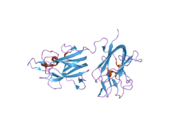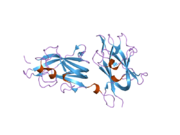Biology:Neuropilin 1
 Generic protein structure example |
Neuropilin-1 is a protein that in humans is encoded by the NRP1 gene.[1][2][3] In humans, the neuropilin 1 gene is located at 10p11.22. This is one of two human neuropilins.
Function
NRP1 is a membrane-bound coreceptor to a tyrosine kinase receptor for both vascular endothelial growth factor (for example, VEGFA) and semaphorin (for example, SEMA3A) family members. NRP1 plays versatile roles in angiogenesis, axon guidance, cell survival, migration, and invasion.[supplied by OMIM][3]
Interactions
Neuropilin 1 has been shown to interact with Vascular endothelial growth factor A.[1][4]
Role in COVID-19
Research has shown that neuropilin 1 facilitates entry of SARS-CoV-2 into cells, making it a possible target for future antiviral drugs.[5][6]
Implication in cancer
Neuropilin 1 has been implicated in the vascularization and progression of cancers. NRP1 expression has been shown to be elevated in a number of human patient tumor samples, including brain, prostate, breast, colon, and lung cancers and NRP1 levels are positively correlated with metastasis.[7][8][9][10][11][12]
In prostate cancer NRP1 has been demonstrated to be an androgen-suppressed gene, upregulated during the adaptive response of prostate tumors to androgen-targeted therapies and a prognostic biomarker of clinical metastasis and lethal PCa.[7] In vitro and in vivo mouse studies have shown membrane bound NRP1 to be proangiogenic and that NRP1 promotes the vascularization of prostate tumors.[13]
Elevated NRP1 expression is also correlated with the invasiveness of non-small cell lung cancer both in vitro and in vivo.[12]
Target for cancer therapies
As a co-receptor for VEGF, NRP1 is a potential target for cancer therapies. A synthetic peptide, EG3287, was generated in 2005 and has been shown to block NRP1 activity.[14] EG3287 has been shown to induce apoptosis in tumor cells with elevated NRP1 expression.[14] A patent for EG3287 was filed in 2002 and approved in 2003.[15] As of 2015 there were no clinical trials ongoing or completed for EG3287 as a human cancer therapy.
Soluble NRP1 has the opposite effect of membrane bound NRP1 and has anti-VEGF activity. In vivo mouse studies have shown that injections of sNRP-1 inhibits progression of acute myeloid leukemia in mice.[16]
References
- ↑ 1.0 1.1 "Neuropilin-1 is expressed by endothelial and tumor cells as an isoform-specific receptor for vascular endothelial growth factor". Cell 92 (6): 735–45. March 1998. doi:10.1016/S0092-8674(00)81402-6. PMID 9529250.
- ↑ "Neuropilin-2, a novel member of the neuropilin family, is a high affinity receptor for the semaphorins Sema E and Sema IV but not Sema III". Neuron 19 (3): 547–59. September 1997. doi:10.1016/S0896-6273(00)80371-2. PMID 9331348.
- ↑ 3.0 3.1 "Entrez Gene: NRP1 neuropilin 1". https://www.ncbi.nlm.nih.gov/sites/entrez?Db=gene&Cmd=ShowDetailView&TermToSearch=8829.
- ↑ "Neuropilin-1 binds vascular endothelial growth factor 165, placenta growth factor-2, and heparin via its b1b2 domain". The Journal of Biological Chemistry 277 (27): 24818–25. July 2002. doi:10.1074/jbc.M200730200. PMID 11986311.
- ↑ Cantuti-Castelvetri, Ludovico; Ojha, Ravi; Pedro, Liliana D.; Djannatian, Minou; Franz, Jonas; Kuivanen, Suvi; Meer, Franziska van der; Kallio, Katri et al. (13 November 2020). "Neuropilin-1 facilitates SARS-CoV-2 cell entry and infectivity". Science 370 (6518): 856–860. doi:10.1126/science.abd2985. PMID 33082293. Bibcode: 2020Sci...370..856C.
- ↑ "Neuropilin-1 drives SARS-CoV-2 infectivity, finds breakthrough study". MedicalXpress. https://medicalxpress.com/news/2020-10-neuropilin-sars-cov-infectivity-breakthrough.html.
- ↑ 7.0 7.1 "Neuropilin-1 is upregulated in the adaptive response of prostate tumors to androgen-targeted therapies and is prognostic of metastatic progression and patient mortality". Oncogene 36 (24): 3417–3427. January 2017. doi:10.1038/onc.2016.482. PMID 28092670.
- ↑ "Selective upregulation of vascular endothelial growth factor receptors neuropilin-1 and -2 in human neuroblastoma". Cancer 94 (1): 258–63. January 2002. doi:10.1002/cncr.10177. PMID 11815985.
- ↑ "VEGF overexpression in clinically localized prostate tumors and neuropilin-1 overexpression in metastatic forms". International Journal of Cancer 89 (2): 167–71. March 2000. doi:10.1002/(SICI)1097-0215(20000320)89:2<167::AID-IJC11>3.0.CO;2-9. PMID 10754495.
- ↑ "Vascular endothelial growth factor is an autocrine survival factor for neuropilin-expressing breast carcinoma cells". Cancer Research 61 (15): 5736–40. August 2001. PMID 11479209.
- ↑ "Neuropilin-1 in human colon cancer: expression, regulation, and role in induction of angiogenesis". The American Journal of Pathology 164 (6): 2139–51. June 2004. doi:10.1016/s0002-9440(10)63772-8. PMID 15161648.
- ↑ 12.0 12.1 "Targeting neuropilin 1 as an antitumor strategy in lung cancer". Clinical Cancer Research 13 (16): 4759–68. August 2007. doi:10.1158/1078-0432.CCR-07-0001. PMID 17699853.
- ↑ "Neuropilin-1 expression by tumor cells promotes tumor angiogenesis and progression". FASEB Journal 14 (15): 2532–9. December 2000. doi:10.1096/fj.00-0250com. PMID 11099472.
- ↑ 14.0 14.1 "A peptide corresponding to the neuropilin-1-binding site on VEGF(165) induces apoptosis of neuropilin-1-expressing breast tumour cells". British Journal of Cancer 92 (2): 328–33. January 2005. doi:10.1038/sj.bjc.6602308. PMID 15655556.
- ↑ "Vegf peptides and their use (WO 2003082918 A1)" (patent). Oct 9, 2003. http://www.google.com/patents/WO2003082918A1?cl=en.
- ↑ "Identification of a natural soluble neuropilin-1 that binds vascular endothelial growth factor: In vivo expression and antitumor activity". Proceedings of the National Academy of Sciences of the United States of America 97 (6): 2573–8. March 2000. doi:10.1073/pnas.040337597. PMID 10688880. Bibcode: 2000PNAS...97.2573G.
Further reading
- "Signaling transduction mechanisms mediating biological actions of the vascular endothelial growth factor family". Cardiovascular Research 49 (3): 568–81. February 2001. doi:10.1016/S0008-6363(00)00268-6. PMID 11166270.
- "Neuropilin is a receptor for the axonal chemorepellent Semaphorin III". Cell 90 (4): 739–51. August 1997. doi:10.1016/S0092-8674(00)80534-6. PMID 9288753.
- "Neuropilin-2 is a receptor for semaphorin IV: insight into the structural basis of receptor function and specificity". Neuron 21 (5): 1079–92. November 1998. doi:10.1016/S0896-6273(00)80625-X. PMID 9856463.
- "Semaphorin-neuropilin interactions underlying sympathetic axon responses to class III semaphorins". Neuron 21 (6): 1283–90. December 1998. doi:10.1016/S0896-6273(00)80648-0. PMID 9883722.
- "Semaphorins A and E act as antagonists of neuropilin-1 and agonists of neuropilin-2 receptors". Nature Neuroscience 1 (6): 487–93. October 1998. doi:10.1038/2203. PMID 10196546.
- "Human neuropilin-1 and neuropilin-2 map to 10p12 and 2q34, respectively". Genomics 57 (3): 459–60. May 1999. doi:10.1006/geno.1999.5790. PMID 10329017.
- "Differential binding of vascular endothelial growth factor B splice and proteolytic isoforms to neuropilin-1". The Journal of Biological Chemistry 274 (30): 21217–22. July 1999. doi:10.1074/jbc.274.30.21217. PMID 10409677.
- "Cloning and characterization of neuropilin-1-interacting protein: a PSD-95/Dlg/ZO-1 domain-containing protein that interacts with the cytoplasmic domain of neuropilin-1". The Journal of Neuroscience 19 (15): 6519–27. August 1999. doi:10.1523/JNEUROSCI.19-15-06519.1999. PMID 10414980.
- "Plexin-neuropilin-1 complexes form functional semaphorin-3A receptors". Cell 99 (1): 59–69. October 1999. doi:10.1016/S0092-8674(00)80062-8. PMID 10520994.
- "Plexins are a large family of receptors for transmembrane, secreted, and GPI-anchored semaphorins in vertebrates". Cell 99 (1): 71–80. October 1999. doi:10.1016/S0092-8674(00)80063-X. PMID 10520995.
- "Identification of a natural soluble neuropilin-1 that binds vascular endothelial growth factor: In vivo expression and antitumor activity". Proceedings of the National Academy of Sciences of the United States of America 97 (6): 2573–8. March 2000. doi:10.1073/pnas.040337597. PMID 10688880. Bibcode: 2000PNAS...97.2573G.
- "Neuropilin-2 is a receptor for the vascular endothelial growth factor (VEGF) forms VEGF-145 and VEGF-165 [corrected]". The Journal of Biological Chemistry 275 (24): 18040–5. June 2000. doi:10.1074/jbc.M909259199. PMID 10748121.
- "The interaction of neuropilin-1 with vascular endothelial growth factor and its receptor flt-1". The Journal of Biological Chemistry 275 (35): 26690–5. September 2000. doi:10.1074/jbc.M003955200. PMID 10842181.
- "Genomic organization of human neuropilin-1 and neuropilin-2 genes: identification and distribution of splice variants and soluble isoforms". Genomics 70 (2): 211–22. December 2000. doi:10.1006/geno.2000.6381. PMID 11112349.
- "Systematic subcellular localization of novel proteins identified by large-scale cDNA sequencing". EMBO Reports 1 (3): 287–92. September 2000. doi:10.1093/embo-reports/kvd058. PMID 11256614.
- "Vascular endothelial growth factor receptor-2 and neuropilin-1 form a receptor complex that is responsible for the differential signaling potency of VEGF(165) and VEGF(121)". The Journal of Biological Chemistry 276 (27): 25520–31. July 2001. doi:10.1074/jbc.M102315200. PMID 11333271.
- "Somatic mutation of vascular endothelial growth factor receptors in juvenile hemangioma". Genes, Chromosomes & Cancer 33 (3): 295–303. March 2002. doi:10.1002/gcc.10028. PMID 11807987.
 |




